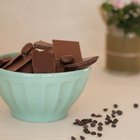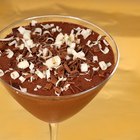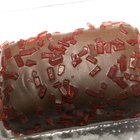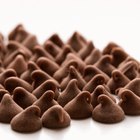
To many people, chocolate is chocolate, distinguished only by characteristics such as milk or dark. However, there are important differences between the chocolate you eat in the form of candy bars or boxed chocolates and the chocolate used for baking and cooking. Recipes that call for specific brands of chocolate candy have been adapted for eating chocolate, but others require baking chocolate.
Baking Chocolate
Also called plain or bitter chocolate, conventional baking chocolate is chocolate in its most basic form. It is made from chocolate liquor and contains between 50 and 55 percent cocoa butter. Baking chocolate typically contains no sugar and has a pungent, bitter taste that makes it inconsumable right out of the package. Some baking chocolates are lightly sweetened, such as semisweet chocolate chips, and eaten out of hand by consumers who enjoy chocolate with more bite and less sweetness. You can store baking chocolate for several years if it's tightly wrapped and stored in a cool, dark place with adequate air circulation.
Eating Chocolate
Candy bars and boxed individual chocolates contain chocolate with various additives for flavor enhancement. Sugar, vanilla and milk solids added to chocolate make it sweeter and more able to melt in the mouth. These stabilizers enhance the taste of eating chocolate, but make it undesirable for cooking and baking as it doesn't melt evenly and tends to separate when heated.
Tempered Chocolate
Both baking and eating chocolate are tempered when you buy them, which means it's been processed so the crystals in it have properly formed and developed. However, if those crystals are altered, the chocolate loses its temper. Eating chocolate left in a hot place loses its temper and develops a white-gray finish when it rehardens, caused by the cocoa fat rising to the top. This doesn't affect the taste, only the appearance. Baking chocolate loses its temper when you chop it up and melt it to use for molds, candy coatings or dipping and has to be re-tempered to restore its sheen for the finished product. This process requires careful heating to specific temperatures and beating it constantly to prevent seizing, which makes the chocolate grainy and leaves it with a dull finish.
Melting Chocolate
When a recipe calls for melted baking chocolate as an ingredient, you can use one of two methods. Use baking chocolate bars instead of chips. Chocolate chips have less cocoa butter in them so they keep their shape during baking, making them more difficult to melt and they have less flavor than bars. You can melt the chocolate in a microwave by breaking it into small pieces and heating it at 50-percent power for 30 seconds in a microwave-safe bowl. Stir and repeat the process until all the chocolate is melted. To melt it on the stovetop, place it in a bowl over barely simmering water or in the top of a double boiler and stir until melted.
Related Articles

Can You Freeze Chocolate?

Which Country Produces the Most ...

Difference Between American and ...

How to Make Homemade Chocolate

How to Make Chocolate Ganache With ...

Can You Substitute Semi Sweet Morsels ...

How to Make Chocolate Vodka

Can I Thicken Ganache With Powdered ...

FDA Standards of Chocolate Identity

How to Melt Hershey's Chocolate

How to Melt Chocolate Chips and Keep ...

What Is Chocolate Used For?

How to Make Chocolate Sculptures

How to Make Hard Candy With Syrup

How to Make Your Own Chocolate Truffles

Swiss Chocolate Facts

Does Cream-Based Frosting Have to Be ...

Ganache Substitute

Calories in Dark Chocolate Truffles

How to Substitute Cocoa Powder for ...
References
Writer Bio
Cassie Damewood has been a writer and editor since 1985. She writes about food and cooking for various websites, including My Great Recipes, and serves as the copy editor for "Food Loves Beer" magazine. Damewood completed a Bachelor of Arts in English with an emphasis in creative writing at Miami University.
Photo Credits
Stockbyte/Stockbyte/Getty Images